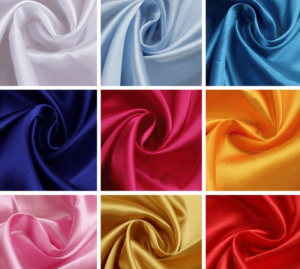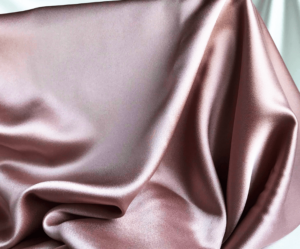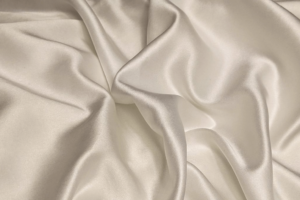A Details Guide On Silk Fabric Material

Ammy Harryy, a devoted advocate for sustainable fashion and mindful…
What is silk abric, and where does it come from? Silk is a natural fiber made from the cocoons of silkworms. The worms spin the fiber to make their cocoons.
Silk has been used for thousands of years to make clothing, accessories, and decor. It’s a luxurious material that’s soft and smooth to the touch. Learn all about silk in this guide.
What Is Silk Fabric?
Fabric made from raw silk is called silk. The raw silk is produced by larvae of the mulberry silkworm. The production of raw silk begins with the breeding of domesticated moth species.
During the larval stage, the larvae spin cocoons made of raw silk fiber. The fiber from the cocoon is then unwound and combined to make a thread.
The most commonly used silk fabrics are satin, chiffon, and taffeta. Silk satin has a shiny surface with a dull back. It is made with a tightly woven, high-thread-count fabric.
The yarns used in satin weave are continuous filament fibers. Silk chiffon is a lightweight, semitransparent fabric with a slightly crepe-like texture.
It is made with an open weave that uses high-twist yarns. Silk taffeta is a crisp, smooth fabric with a slight sheen. It is made with tightly twisted yarns that are woven into a plain weave fabric.
History Of Silk
Silk is a luxurious material with a long and fascinating history. The production of silk dates back to ancient China, and it was once a highly coveted item that was only available to the elite. Over time, the production of silk spread to other parts of Asia, and eventually to Europe. Today, silk is still prized for its beauty and elegance.
There are many different types of silk fabrics, each with its own unique properties. For example, crêpe georgette is a lightweight silk fabric with a crinkled texture. It’s often used for making sheer fabrics like blouses and dresses.
Another popular type of silk is charmeuse, which has a satin finish and a smooth, lustrous surface. Silk is also often used in home furnishings like curtains and upholstery.
Whether you’re looking for fabric for a special occasion or you simply want to add a touch of luxury to your home, silk is an excellent choice. Thanks to its rich history and beautiful appearance, silk remains one of the most popular textile materials in the world.
Types Of Silk Fabric

Silk is a natural protein fiber, some forms of which can be woven into textiles. The protein fiber of silk is composed mainly of fibroin and produced by certain insect larvae to form cocoons.
Silk production occurs in many insects but most notably in the caterpillars of the silkmoth Bombyx mori.
Mulberry Silk
This is the most common type of silk and is produced by the larvae of the domesticated silkmoth Bombyx mori fed on mulberry leaves.
Tussah Silk
This type of silk is produced by larvae of several wild silkmoths including Antheraea pernyi and A. paphia that feed on oak, maple, or walnut leaves.
ERI Silk
This is a type of wild silk produced by the larvae of Samia ricini that feed on the castor oil plant.
Muga Silk
This is a type of wild silk produced by the larvae of Antheraea assamensis that feed on the leaves of the muga tree.
What Makes Silk Fabric A Sustainable Option?
silk is a sustainable fabric option silk is made by silkworms silk farms the silk industry has a positive environmental impact requires less water to cultivate than cotton silk farming silk warehouses USDA National Organic Program certified silk dyes used in silk painting are non-toxic and biodegradable.
Gentle on the skin pre-washed and doesn’t require dry-cleaning can be dyed any color very versatile can be used for all types of clothing including: shirts, dresses, pants, skirts, jackets, and more eco-friendly biodegradable durable hypoallergenic absorbent comfortable lightweight moth resistant renewably sourced silk manufacturing produces little waste creates jobs in developing countries.
The silk industry has a positive environmental impact and requires less water to cultivate than cotton.
Silk farming creates jobs in developing countries and produces little waste. Silk fibers are a sustainable fabric option that is biodegradable, hypoallergenic, absorbent, comfortable, lightweight, moth resistant, and renewably sourced.
How is Silk Turned Into Fabric?
When it comes to fabric, there are many different materials that can be used. One of the most popular materials is silk. Silk is a luxurious material that has a soft feel and a beautiful sheen. But how is silk turned into fabric?
Silk is produced by silkworms. The worms spin a cocoon around themselves made of a protein called fibroin. To get the silk, the cocoons are boiled, and the fibers are then unwound and woven into fabric.
There are different types of silk fabric. For example, tight weave fabrics like taffeta or crepe de chine are typically used for evening wear or special occasion dresses.
On the other hand, medium weight fabrics like shantung or charmeuse are more versatile and can be used for both casual and dressy clothing.
And finally, polyester satin is a synthetic fabric that is often used for lining garments because it has a smooth surface.
So next time you see a beautiful silk velvet dress or silk jersey, now you’ll know how that durable fabric was made!
The Pros Of Silk

Whether silk organza or silk georgette, it is soft, supple and has a beautiful luster that makes it a luxurious fabric to wear. It’s a medium weight fabric that drapes well and is often used for eveningwear and bridal gowns because it’s so elegant.
Silk fabrics are made from the natural fiber produced by silkworms to make their cocoons.
The fabric is delicate so special care needs to be taken when wearing or washing it, but it’s worth the effort as silk is such a beautiful material.
When buying silk, look for a quality fabric that has been woven properly so that it will last longer and keep its shape. Also, be sure to check the care label before purchasing as some silk garments require dry cleaning only.
With proper care, silk can be a timeless addition to your wardrobe that will be treasured for years to come.
The Cons of Silk
Silk is a natural protein fiber, some forms of which can be woven into textiles. The protein fiber of silk is composed mainly of fibroin and produced by certain insect larvae to form cocoons.
The best-known type of silk is obtained from the cocoons of the larvae of the mulberry silkworm Bombyx mori reared in captivity (domestic silks).
The shimmering appearance of silk is due to the triangular prism-like structure of the silk fiber, which allows silk cloth to refract incoming light at different angles, thus producing different colors.
Silk fabric has a rough texture that many people do not enjoy. Shot silk is a type of plain weave silk fabric in which warp and weft yarns are complementary colors.
This gives the fabric a shimmery appearance. It is less durable than other types of silk fabrics.
Best Popular Silks In The Market
Here a few popular silks in the market:
China Silk
china silk has been around for centuries and is one of the most popular fabrics in the world. It is made from the fibers of the mulberry plant and is incredibly strong and durable.
Silk is also a very versatile fabric and can be used for a wide range of garments including dresses, blouses, shirts, and even pants.
Spun Silk
Spun silk is a type of fabric that is made from the waste silk that is left over after the production of other silk products. It is often used in a variety of garments including dresses, shirts, and even pants.
Peace Silk
Peace silk, also known as Ahimsa silk, is a type of silk that is produced without harming the insects that produce it. The most common type of peace silk is produced from the cocoons of wild silkworms.
This type of silk is often used in a variety of garments including dresses, shirts, and even pants.
Noil Silk
Noil silk is a type of fabric that is made from the waste silk that is left over after the production of other silk products. It is often used in a variety of garments including dresses, shirts, and even pants.
Devoré Silk
Devoré silk is a type of fabric that is made by printing a design onto a piece of silk and then dissolving the unprinted areas in a chemical bath.
This leaves the printed design on the fabric. Devoré silk is often used in a variety of garments including dresses, shirts, and even pants.
The Impact Of Silk

The making of silk is a labor-intensive process that has been around for over 5,000 years. First, the mulberry leaves are harvested and then the silkworms are fed the leaves.
Once the worms have cocooned themselves in silk, the cocoons are boiled so that the long silk threads can be unwound and used to weave fabric.
Silk is a very supple fabric, making it ideal for dresses, blouses, and lingerie. It is also a surprisingly strong fabric, able to withstand a great deal of wear and tear.
In addition, silk is lightweight and breathes well, making it a good choice for summer clothing. Unfortunately, silk is also one of the most expensive fabrics on the market.
Nonetheless, its many virtues continue to make it a popular choice among fashion designers and their customers alike.
Impact Of Silk On Planet
The Impact of Silk Planet on the Environment The environmental impact of the silk planet is often overlooked because it is such a delicate, natural-seeming product.
However, the process of making the silk planet creates significant pollution problems. Firstly, the farming of silkworms for their cocoons creates large amounts of waste.
Secondly, the processing of silk planet generates hazardous chemicals which pollute both air and water. Finally, the use of silk planet in garments often results in the release of microplastics into the environment.
All of these impacts have serious consequences for both ecosystems and human health. In order to reduce the environmental impact on the silk planet, we must take care to choose eco-friendly options at every stage of production, from farming to garment manufacture.
Impact Of Silk On Animals And People
The impact of silk on animals and people is both significant and far-reaching. For animals, the production of silk requires the domestication and exploitation of silkworms.
Wild silkworms are killed in the process of collecting their cocoons, and those that are used for commercial production are typically kept in captivity and fed a diet of mulberry leaves.
This demand for mulberry leaves has led to the clearing of large tracts of land, which has, in turn, had a negative impact on local ecosystems.
In addition, the use of harmful pesticides and chemicals in silk production can pollute waterways and negatively impact both human and animal health.
For people, the impact of silk is largely economic. The high cost of silk production means that it is often only accessible to the wealthy.
In addition, the majority of the world’s Silk is produced in China, which gives the country a considerable amount of political and economic power.
Finally, the use of child labor in silk production is well-documented, with children as young as five working long hours in dangerous conditions. The impact of silk on animals and people is thus complex and wide-ranging.
Conclusion
So there you have it, everything you ever wanted to know about silk.
Whether you’re looking for a luxurious fabric for your next sewing project or just curious about the many uses of this amazing material, we hope this guide has been helpful.
And don’t forget, if you need any help sourcing silk fabrics or want us to sew something special for you, our team is always happy to chat. Thanks for reading!
More Sustainable Guide You’ll Love to read:
Apple Leather Fabric Guide (Everything You Want to Know)
Sustainable Viscose Fabric Material Guide
Seacell Fabrics Material Guide For Fashion Designer
Cork leather, a Sustainable material?
Wool Fabric Guide, Everything you need to know
Get to know about Econyl Fabric
Vegetable Tanned Leather Material Guide
A Details Guide On Down Fabric Material
What Is Camel Fabric,How It Made?(Everyhing You Want To Know)
Details Material Guide On Cashmere Fabric
What is Alpaca Wool Fabric? History, How It’s Made
Recycled Polyester Fabric Details Guide
Cupro Fabric Material Guide (Is It Sustainable?)
Woocoa Fabric Material Guide (Why It’s Expensive)
Organic Bamboo Fabric Guide (Eco Friendly)
Modal Fabric Guide (Everything You Need to Know)
Sustainable Ecovero Fabric Material Guide (All Details)
Details Material Guide On Pinatex Fabric
A Details Guide To Scoby Leather Fabric
Ammy Harryy, a devoted advocate for sustainable fashion and mindful living, exudes a profound passion for nature and the environment. Her mission intertwines style and consciousness, inspiring eco-friendly choices. With her words, Ammy envisions a world where fashion harmonizes with the planet, urging readers to take small steps toward a greener future.



